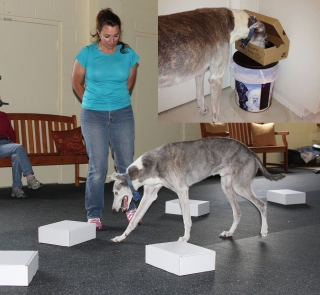A Sighthound's Adventure in Nose Work

When you are the parent of an older, somewhat impaired dog, it can sometimes seem like the fun and games are over for the most part and that all you can do is love them to pieces while you can. Enter K9 Nose Work for companion dogs. This sport has been around for about 5 years now and is a fun activity to do with dogs of various abilities and skill levels.
One of my three retired racing greyhounds is a calm, 10-year-old “wise old sage” male named Manx. Unfortunately, Manx has some back injuries due to his racing career and is not allowed to run at top speed anymore for fear of exacerbating them. Many of the fun dog activities like agility and lure coursing are off limits for him now, so imagine my excitement when a nose work class came to town! The icing on the cake was that it was taught by Penny Scott Fox, CNWI, one of the founding nose-work instructors in the country. I thought it would be a perfect activity for old Manx, who loves to sniff around on walks and play with food-oriented puzzle games at home too. As a professional pet dog trainer, the thought of taking a class rather than teaching one was more than a tiny bit enticing too.
There are many interesting aspects of nose work that are vastly different from typical companion animal basic skills and manners classes. For starters, the dogs are not encouraged or allowed to interact with each other at any time during the hour, even when arriving and leaving, so it’s a great activity for dog-reactive dogs who aren’t often taken to classes. It’s all about keeping them focused on the reason why they are there--to sniff out the target smell. All of the dogs are kept crated until it’s their turn to work to minimize distractions for the working dog. In our class there are all sorts of different dogs, including a Border Collie, Labrador, Mini Schnauzer, Papillon and more. My dog Manx is by far the oldest student with the longest nose and technically speaking, the fastest (when it comes to the quarter mile), but you would never know it from his search technique. It’s been fascinating to see the different learning curves and hunting styles of each of the dogs. Some dogs buzz around like busy bees until they catch the scent, making circles and figure eight patterns all over the place. Manx’s search style is very cerebral and efficient. He trots into the space, pauses, and then goes right to the scent! Not a drop of wasted energy expended.
In the beginning we did box searches with high value treats. The box lids were in various stages of openness. As a sighthound, Manx had a tendency to use his eyes, not his nose, to go to the box that he could see with an open lid. If the lid was mostly closed he would just stare at it, rather than aggressively try to get the treat out like some of the other dogs did. His homework the first week was to become more relaxed about taking food out of a box, so he had to eat all of his meals out of a box (see inset photo). As time progressed the boxes were elevated, which made it easier for him since he is quite tall and the scents were closer to his nose level rather than on the ground. Next we moved on to searches among common household items like backpacks, laundry baskets and furniture.
One of the best things about nose work is the silence. The silence is wonderful. After the handler cues the dog to “Search!” that’s it, no more talking. The dog learns to work it out for himself. Human chatter would be a distraction, particularly for dogs that have been through obedience training, as they tend to look to their handler for direction when they get stuck. In fact, wild and crazy untrained puppies make great nose work dogs since they don’t have a sense of boundaries. Clickers or another bridging stimulus are not used in nose work since you have no way of knowing the exact moment when the dog first picks up the scent. This is a sport where the dogs use their natural “dogness” to find the target scent, they don’t really need our help at all.
In future sessions we’ll pair an odor like spearmint or something similar with the treat, and then finally just hunt for the odor and reward with the treat. I can’t wait to see how my wise old methodical sage does in those sessions. Who knows, once he completes Introduction to Nose Work Level 1, we might just go on to more and more challenging levels. It turns out you can teach an old dog new tricks, and a sighthound can give a scenthound a run for their money!




